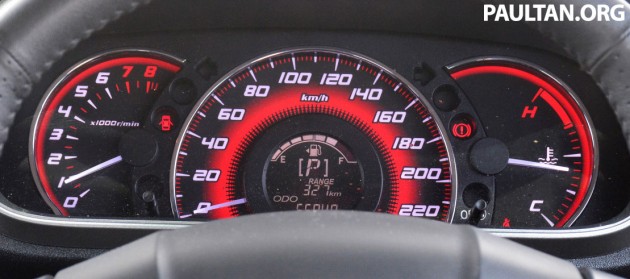A blog post on the Perodua Myvi and Alza’s self-illuminating instrument cluster written by a retired expat named Wolf Vaupel has been going viral on social media over the weekend. The blog post alleges that there is something wrong with the way the Myvi and Alza’s instrument cluster works.
Here’s how the story goes – the expat’s wife bought a Perodua Myvi in August 2014. He discovers the car’s self-illuminating meter panel which lights up during the day and claims in his blog that the feature is “deadly” because according to him, a lit up meter panel is an indication of whether your headlights are on. He further claims that this type of behaviour does not comply to international standards.
UPDATE: Perodua CEO Datuk Aminar Rashid Salleh has issued an official statement on the matter.
The Perodua Myvi that he is talking about features a self-illuminating meter panel that use a different type of backlight compared to regular meter panel. Some car manufacturers have special brand names for this type of panel – Toyota calls it Optitron while Kia calls it SuperVision.
Watch the video above for a video we recorded back in 2011 when the second-generation Perodua Myvi was launched. This type of meter panel generally looks more premium, but will appear completely black if there is no backlight. The meter panel requires to be lit up to function, there’s no two ways about it.
So if the meter panel is always on, how would someone know whether your headlamps are on or not? Some cars have a headlamp symbol that lights up in your meter panel, so you can look out for that. If you have been using an illuminated meter panel as an indicator, it’s time to stop, because Optitron-style panels are becoming used more often these days.
It’s also worth noting that with the 2015 Perodua Myvi facelift, Perodua has taken out the Optitron-style panels and replaced them with cheaper regular meter panels which don’t light up when the headlamps are off. Only the Alza still has Optitron-style panels.
If you feel you need a little more help in determining whether your headlamps are on or not, there are usually differences with the interior lighting of your car depending on whether your headlamps are on or not.
Watch the video above (thanks to MY Neo for the help recording it), which shows that when the headlamps are on, the meter panel actually dims to suit the night environment, and the other buttons on the center dash stack light up for night usage, where they remained off when the headlamps were off. So there is clearly a difference in the behaviour of the interior lighting.
We double checked some of the other cars in our fleet. Anthony Lim’s Ford Focus ST and previous generation Honda CR-V facelift which both have Optitron-style panels do not even differentiate the brightness of the panel between day and night by default – this must be set manually.
However, you can make some adjustments to the settings so that there can be a difference in brightness between night and day. That way, you can be reminded – if the meter panel is too bright, your headlamps are probably not turned on.
So if you have a car with the increasingly common Optitron-style meter panel, it’s time to learn to remember to turn the lights on some other way. We used to be able to be conveniently reminded with the meter panel backlight, but that’s going to be increasingly rare in the future.
Looking to sell your car? Sell it with Carro.


















AI-generated Summary ✨
Comments mainly focus on the lack of an indicator for headlamp activation in the Perodua Myvi, with many asserting it’s a safety concern and a flaw in design that could lead to accidents. Several mention that auto headlamp systems could resolve this issue, but others argue it’s ultimately the driver’s responsibility to turn on their headlights. There’s criticism of Malaysian drivers’ general attitude toward road safety and a call for better education and standards. Some comments compare this to international standards, noting that many modern cars, including European models, feature clear headlamp indicators or auto lighting. Overall, the sentiment emphasizes safety, the need for clearer indicators, and concerns about local manufacturers neglecting this feature to cut costs.